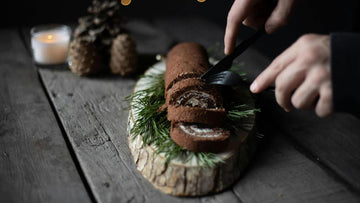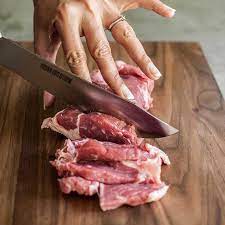Mastering the Art of Culinary Craftsmanship: How to Use a Wooden Cutting Board Like a Pro:
by Jerry Barker on Dec 20, 2023

A wooden cutting board is useful to you since it elevates your cooking experience and even goes beyond by offering other benefits. On the contrary, wooden cutting boards do not damage your knife thereby providing prolonged sharpness.
Wood’s natural characteristic also has antibacterial effect that lessens the chance of contaminated foods.
Cutting wood also provides attractive and convenient surfaces for serving your food in a plate like manner enhancing the taste of your cooked meal.
Selecting the right wooden cutting board for your kitchen:
The type of wooden cutting board you choose will determine how effectively you can succeed in your culinary adventures. Choose the cutting board made of maplle wood cutting board boos wood cutting board or cherry board to achieve better results.
Selecting a good-sized cutting board that still fits nicely into our kitchen is essential; we must therefore have sufficient working room.
Lastly, look at the length and depth of the cutting board. A board measuring 12 by 18 inches should be enough for most home cooks who want ample space for cutting. A recommended thickness should be 1.5 to 2 inches so that the cup remains stable in use.
choosing a wooden cutting board will therefore be based on your way of cooking since it entails other aspects such as taste for art and pocket size.
With knowledge about different kinds of timber, hardwoods, grain patterns, and boards sizes, you will purchase an attractive piece that suits for serving your food.
Essential techniques for using a wooden cutting board:
Taking care of a wooden cutting board may improve its lifespan, preserve the sharpness of the knife, as well as secure an individual’s food safety.
Put a damp cloth:
The first strategy, in this regard, involves maintaining balance on the board. The knife accident is more prone in a sliding or unstable cutting board damaging it as well. Put a damp cloth or a rubberized pad below the board as you chipped and sliced onto to avoid movement.
Do not apply much pressure:
Do not apply much pressure while cutting as it may lead to deeper gouges in the wood where bacteria’s can grow. Rather than that, let a sharp knife do all such tasks.
Knife board is made of wood and wooden boards are more sharp friendly than plastic or glass board which makes them become dull faster. Nevertheless, a blunt knife can mar the board and leave an undulating finish.
Preventing Cross-Contamination:o
This notion of employing separate cutting boards for diverse kinds of food is paramount in averting cross-contaminations.
It is advisable to have at least two boards: firstly, a separate one for raw meats, poultry and fish only, and secondly, a different one reserved for fresh fruits, vegetables, and bread that is all set for consumption. The separation prevents bacterial exposure of ready-to-eat foods by raw foods.
Additionally, it is important to decontaminate the board after every application, particularly following cut of raw meat.
You can ensure that your board is clean by simply using a warm, soapy water to wash over and dry it immediately.
However, do not immerse the board in water, put it into a dishwasher – prolonged access of water can warp and crack the wood.
Innovative recipes and culinary creations using a wooden cutting board:
Indeed, using a wooden cutting board opens up a universe of food possibilities whereby you can unleash your creativity in cooking.
A solid wooden cutting board can provide the perfect canvas for displaying your artistic skills in the preparation of juicy assembling vibrant charcuterie boards or even more visually stunning fruit and cheese platter.
The wooden cutting board also serves as a presentation platter for various cuisines like sushi, tapas, and artisan sandwiches that are prepared for artisanal dining.
Trying unusual ingredients and textures on a cutting board creates new taste sensations that may excite you, as well as your guests.
Mastering the art of knife skills on a wooden cutting board:
Precision and speed are vital when using a wooden cutting board so it’s important to master knife skills. How you take hold of the knife, together with how your fingers are positioned all matter when it comes to safety and control as far as use of a wood cutting board is concerned.
Learn to cut with different cuts; rock chop and tap chop for instance to develop dexterity and confidence with different ingredients.
Furthermore, knowing the anatomy of various types of knives and how they serve different purposes gives the ability to fully utilize them on a wooden chopping block.
Sharpen your knife skills using various slicings, dice, chopping, mince and filleting to be creative in your craftsman.
Care and maintaince:
However, cleaning of wood cutting board should be done right as it serves the purpose of hygienic and increasing the lifespan, too.
Start it off by peeling away the leftover food on the panels through a bench scraper or a spatula. Warm, soapy water should be used to wash the board after that.
Clean the surface and sides of the board using a soft scrub brush or cloth gently. Do not let the board sit in water for long periods, nor should you put it in the dishwasher as this may lead to the wood warping or cracking.
After that, wash the board with warm water. Finally, use your towel to dry off your board because it should not be wet.
Place the board upright for complete drying before placing it in store. This eliminates any remaining moisture which could cause the wood to be warped by mildewed.
Regularly Oiling Your Cutting Board:
Oil your wooden cutting board on a regular basis. If wood is repeatedly washed over a long period of time, it may get dried up and consequently develop cracks and splits. Oiling the board refills the moisture in the wood and maintains its strength as well as durability.
You will require for food-grade mineral oil or special cutting board’s oil to oil your board. Apply some oil on a clean and dry rag then spread it over the wooden surface along the grainline directions.
Allow the oil to soak for a night and then clean up any remaining oil on the following day. You may have to do it several times especially if it’s a new board or a dry one, until it stops soaking in oil.
Common Mistakes to Avoid:
Some frequent wrong practices regarding wood cutting boards use might be very harmful in extending their useful life.
Using the Same Board for Different Foods:
For instance, cutters often make a mistake with the very same cutting boards being used for all types of foods.
The use of this type of board can cause cross-contamination, especially in cases when a single board is used for both raw and cooked foods.
These are two separate solutions – to make sure we have at least two boards; one for fresh meats and another for fruits/vegetables/cooked food.
Not Cleaning the Board Immediately:
Others even ignore to dry a clean and washed cutting board. Such neglect causes warping of the wooden cutting boards or growing bacterias. Wash down and dry up your board straight away, store it only after you are certain that it is not damp.
Using Harsh Cleaners or Dishwashers:
It would be advisable to avoid using chemicals and cleaning cutting boards with wood in a dishwasher.
Such practices may also lead to cracking of the wood and its drying out. Rather, clean the board with mild soap and warm water and oil up the board regularly to preserve its moistness.
Not Oiling the Board:
Most people often fail to remember the crucial step of seasoning their wooden carving boards. This may causes the wood to dry and shrink hence cracking. The board can be kept in good condition and used for longer via regular treatment with food-grade mineral oil.
Cutting with Dull Knives:
This is because using dull knives could end up damaging the surface of the board, and creating the groove where bacteria can be hidden. Make sure that your knives are sharp before you use them on a wooden board.
You will note that by understanding and evading such blunders you will guarantee that your wood cutting surface stays helpful, safe, and lovely for quite a while.
Safety considerations when using a wooden cutting board:
A wooden cutting board enhances the culinary experience but care must be taken that no one gets harmed in the kitchen. Make sure you put your cutting board onto solid, steady and slip-resistant surface to avoid accidents when doing some food preparing tasks.
Also keep your stance upright when handling sharp objects on the wooden board so that you can minimize chances of getting injured.
Inspect your cutting board for cracks or deeply grooved surface regularly, and always replace it when necessary to prevent exposure to accidents and injury.
You should observe safety methods when handling a piece of wood and be cautious with your approach. By doing so, you will not feel pained and other people would be safe too.
FAQs:
Is it possible to fix a broken wooden chopping board?
Sometimes, small cracks in a wooden cutting board can easily be resolved through sanding and oiling the damaged portion. While large portions of the cutting board could be destroyed, you have to replace it if it is safe for both optimal safety and function.
How to Clean a Wooden Cutting Board With Bleach?
Combine one tablespoon of bleach in one gallon of water. Then, wipe the solution onto the surface of the board and allow it to stay there for several minutes. Warm wash thoroughly and then air-dry.
How to clean a wooden cutting board with lemon?
Cut a lemon in half. Half should be dipped in coarse salt and rubbed over the board to wipe out stains and smells. Wipe with a clean, dry, soft cloth.
Conclusion:
Using wooden carving, you can perfect the skill of culinary handicrafts and develop masterpiece meals. However, by exploiting the advantages of wood cutting board, choosing appropriate one for your kitchen and practicing key rules, you’ll reveal your cook’s talents and excite your sense on any meal which you make.
A wooded cutting board is a faithful friend that will add beauty onto your dishes when cared, and also become an inspiration for any culinary adventure. Using a wood cutting board is a great way to accentuate, express yourself creatively during preparation, and also emphasize on some measures, which include health, when you cook for someone in a professional manner.



